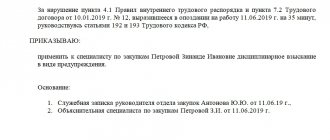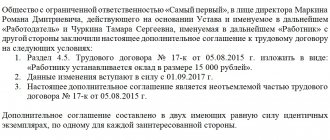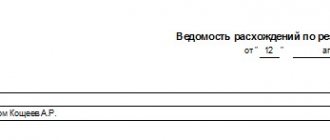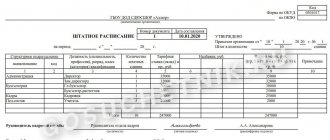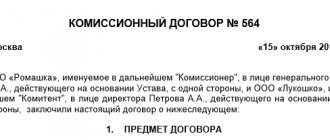Inventory is a check of the condition and compliance with the accounting registers of assets and liabilities of an enterprise; this is a mandatory procedure, the implementation of which, from the first to the final stage, is regulated by law. According to the Methodological Guidelines of the Ministry of Finance, an internal audit is preceded by an order to conduct an inventory. Today's review is dedicated to him.
In this article, you can find out in what cases it is necessary to carry out an internal audit and what is the object of attention of the audit commission, how to prepare a documentary justification for the audit, we will provide a sample for the order to conduct an inventory in 2020, which fully complies with the requirements of the Ministry of Finance.
Inventory in legislative regulations
The procedure for carrying out the activities that make up the inventory procedure is regulated by several regulations:
- Law of the Russian Federation dated December 6, 2011 No. 402-FZ “On Accounting”;
- Order of the Ministry of Finance of the Russian Federation No. 34n dated July 29, 1998 (as amended on April 11, 2018), which approved the Regulations on accounting;
- “Guidelines for inventory of property and liabilities”, approved by Order of the Ministry of Finance of the Russian Federation No. dated June 13, 1995;
In addition to the above-mentioned regulatory documents, the legislation prescribes that a business entity must include regulations for carrying out inventory activities in the accounting policy of the enterprise.
Check results
An inventory is carried out based on inventories of material assets. The results of the inspection are documented in an act or protocol of the inventory commission. The documents are drawn up in two copies, one of which is attached to the event plan, and the second is sent to the financially responsible person.
The act excludes typos and corrections and is filled in with ballpoint paste.
Results of the unscheduled event:
- comparison of the correspondence between the actual quantity and the quantity noted in the documents;
- checking all invoices and receipt orders;
- commercial products are not documented.
The conclusions are indicated in the act. All information about the product is also displayed there, and both the presence and absence of materials are recorded.
The results of the event are reported to management. If inconsistencies are found, these circumstances are studied. Finally, the decision is made:
- Carrying out additional verification. Comments must be eliminated within the time period specified in the action plan.
- If a deficiency is detected, action must be taken.
- If criminal actions of warehouse managers are discovered, the documents are sent for consideration to the prosecutor's office.
The results of the inspection are translated into decisions. If no inconsistencies are found, then nothing needs to be done. But if inconsistencies are identified, action must be taken.
Violations may occur in the following cases:
- occurrence of emergency situations;
- property theft;
- irresponsible storage.
Inventory: main aspects
The legislation draws the attention of business entities to three main aspects of inventory activities:
- timing of inventory;
- reasons requiring an internal audit;
- documentation of inventory.
Inventory deadlines
The period and frequency of the inventory depends on its type.
Mandatory (scheduled) inventory. The timing of its implementation is regulated by law and is focused on the reason for the internal audit. For example, an inventory before the annual report should be carried out at the end of the fourth quarter of the reporting year, when transferring property to third parties or dismissing a financially responsible person - on the eve of the event.
Voluntary (unscheduled) inventory. Carried out in connection with the reasons established by local regulations (order of the manager) and upon their occurrence. Such an inspection does not have an exact timing and is appointed by business entities at their own discretion.
Reasons for taking inventory
The legislator has established a list of cases subject to mandatory inventory. To them, incl. relate:
- preparation for the preparation of annual reporting;
- transfer of property between financially responsible persons (for example, upon dismissal of such a person);
- transfer of property rights to third parties;
- in connection with the theft of property, as well as force majeure - emergencies of a man-made or natural nature (explosions, fires, floods and other disasters);
- before drawing up the liquidation balance sheet.
In addition, business entities can expand the list of cases for conducting internal inspections at their discretion, having approved this by a local act.
Documents for inventory
The mandatory package of documents for an internal audit includes an inventory order, an audit schedule, inventory acts and inventories, a final record of inventory results, an order based on the results of the audit if inconsistencies are found between the fact and the accounting data.
Please pay attention! Since the legislation in clause 27 of Order No. 34n of the Ministry of Finance of the Russian Federation dated July 29, 1998 specifies the cases that fall under mandatory inspections of material assets of business entities, the purpose and reason for the inventory must be indicated in the order, as well as its format (planned, unplanned).
Reasons for inventory in the order
Depending on the reason for which the inventory is planned, the reasons for the inventory are indicated in the order. Let’s say the procedure will be carried out in connection with the transfer of property to an organization for rent. Then in the column “Reason for inventory” in the order you can write: “Preparation for the transfer of property to the organization for rent.” If this is an annual inventory, then the wording will be: “Preparation for the preparation of annual financial statements.” This is exactly what is shown in our example above. Similarly, the reasons for inventory are prescribed in the order for all other cases. The most popular option is “Control check”.
Inventory order: form
The inventory order is a mandatory document, so its form is standardized. This is a unified form No. INV-22 (you can download it here), approved by Resolution No. 88 of August 18, 1998 of the State Statistics Committee of the Russian Federation.
A business entity can issue an order for inventory in form No. INV-22, but can also draw up an administrative document in free form, reflecting all the data necessary for the inspection. The use of a free form of an inventory order does not contradict current legislation under two conditions:
- If the order includes all the mandatory information and instructions for conducting an inventory (indication of inventory activities, the purpose and reasons for the inventory, the composition of the inventory commission, the start and end date of the inspection, the date of submission of the inventory report);
- If the use of a free form of an order to conduct an inventory is provided for by the accounting policy of the business entity and it is provided for by the internal nomenclature of affairs.
Filling out the fields of the INV-22 form
Drawing up an order (resolution) for inventory is an extremely simple procedure. You will need to include OKPO and the name of the structural unit in the header if we are not talking about general inventory or revaluation, but about reporting on the property of a separate branch. If you plan to conduct inspections in several departments, then INV-22, as well as associated forms, will be compiled for each.
The inventory object can be fixed assets, inventories, liabilities, completed or unfinished construction objects, objects in safekeeping, etc.
We indicate “control check” or, more directly, “scheduled inventory” as the reason for the planned inventory. If personnel changes occur - “change of financially responsible persons” or “reorganization”. The resolution is also completed for cases of revaluation.
In the event of a change in responsible persons, storekeepers, cashiers and other specialists employed at the time of the inspection are indicated.
The timing of the assessment must be precise. The start date cannot be earlier than the document date.
After the INV-22 is completed, it should be entered into the journal using the INV-23 form. But the results of the inspection are entered into the journal using the INV-25 form. These documents can remain in the structural unit or be transferred (in the case we discussed above).
Inventory order: sample 2020
If the contents of the administrative document for carrying out inventory activities are brought into compliance with the requirements of the law, then the inventory order (sample 2020 is given below) must contain the following information:
- full name of the business entity;
- name of the document (Order), its registration number and date of publication;
- an order to carry out inventory activities, indicating the units where they will be carried out (for example, a general inspection of all units, or a specific warehouse or unit);
- the purpose of the audit is to take an inventory of tangible assets, fixed assets, inventories, accounts receivable, etc.;
- the composition of the audit commission and the appointment of the Chairman of the commission (when external auditors are involved in activities, their role in the commission is indicated. For example: “Ivanov I.I. – member of the commission, invited auditor”);
- timing of the inventory, with an exact indication of its start, end, and date of submission of the Inventory Report;
- information about the person signing the order - position, surname, initials.
We offer you a free-form sample of an inventory order.
Inventory of fixed assets - documentation
Inventory activities are documented using forms that are established by the organization’s accounting policies. These can be either previously used unified forms or documents developed by the enterprise independently.
Of course, inventory of fixed assets (documentation of inventory) begins with the execution of an order - we discussed its preparation above. During the inventory of fixed assets, data is entered into the inventory records (form No. INV-1). The inventory is compiled in 2 copies - one is transferred to the accounting department, and the other remains with the person responsible for the safety of the OS.
If deviations were identified in the process (for example, as a result of the inventory, a fixed asset was identified), a comparison sheet of inventory results is filled out. The statement is compiled for objects for which deviations were found, also in two copies.
Registration of inventory results
The results are compiled in accordance with the standard INV-18 form, which indicates the numerical characteristics of the company's fixed assets, operating assets, material objects, and also compares the data specified in the documents with the actual presence of certain components.
The results reflect the status of the following objects:
Material objects used for more than one year- Material objects that have been in use for less than a year and have changed their condition
- Operations with further preparation of an expense report (attached as evidence)
- The totality of cash and non-cash funds
- Calculations related to the purchase of goods and services
After creating the protocol and statement, the final determination of the results of the procedure occurs, and an order is signed containing data on the results of the event.
Accounting for surpluses, shortages and re-grading
The commission is engaged in making an inventory of the company's property, analyzing it, and also drawing up the results, indicating specific surpluses and shortages.
It is important to note that the reason that led to a failure in the data and its inconsistency with the facts of the documents should be noted.
What mistakes can be made, watch the video:
In conclusion, we note that inventory is a mandatory procedure for all operating organizations. It allows you to identify deviations from the norm in production assets, and an annual accounting report is also compiled on its basis.
Top
Write your question in the form below
Preparing for an inventory
An inventory is carried out on the basis of an order from the head of the enterprise, drawn up in writing. Next, a special commission is assembled, the composition of which is approved by the head .
It includes at least three people - an accountant, a financially responsible person and other specialists of the required profile. All members of the commission are required to be present during the recount, otherwise the final data may be considered invalid.
If the inspection is a requirement of law enforcement agencies, a representative of them may be present during the inventory , but he is not part of the commission. When conducting a documentary audit, a member of the audit team is included in the composition.
Responsibility of the commission:
- for compliance with the requirements of the manager’s order;
- for the accuracy and timeliness of preparation of inventory results;
- for the completeness and truthfulness of the specified data on the actual balances of material assets.
Before the start of the inspection, the accounting department provides representatives of the commission with the recorded data (book balances) on the actual availability of the values being checked. This information is found in reports on the movement of inventory items and accounting registers.
You can find out how to fill out the inspection and testing log for the power tool and this document here.
The commission checks measuring and weighing equipment and seals storage areas for material assets. Then he invites the person responsible for the MC to register all new expenditure documents, and the head of the commission signs each of them.
If this is a retail enterprise, the commission takes the cash register and determines the revenue. The final stage of preparation is the acceptance of a receipt from the financially responsible person stating that all receipts and expenditure documents have been processed and there is no separately stored property.
Inventory classification
The legislative framework establishes the types of inventory that a company can carry out in accordance with the characteristics of its activities. When creating an order, you need to take into account all types of this event.
Table 1. Types of inventory.
| Classification factors | Classification |
| By degree of obligation | Mandatory (carried out once a year in accordance with the standards specified in the Law “On Accounting”) Initiative (partial inspection carried out by decision of the head of the company) |
| By purpose and nature | Planned (in accordance with the dates specified in advance in the inventory schedule) Sudden (by decision of the manager to ensure additional control over assets) |
| By level of verification completeness | Full (covers all production assets) Selective (considers individual areas of production as objects of inspection) |
| By method of implementation | Natural (checking objects by sequentially measuring and weighing them) Regulatory (checking objects only by analyzing the presence of objects in document format) |
Video with an example of taking inventory:
What is needed for the procedure
To do this, you must have the following documents:
An order signed by the manager to begin the inventory- Reports of persons responsible for the presence or absence of property
- A document containing a comparison of inventory data with information specified in the accounting report
- List of property condition inspection results
